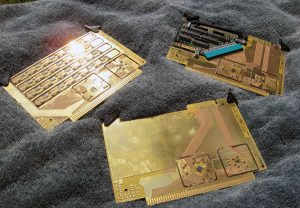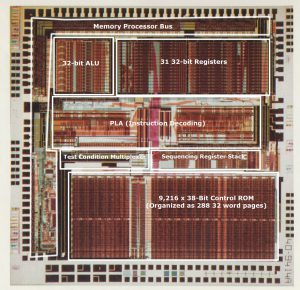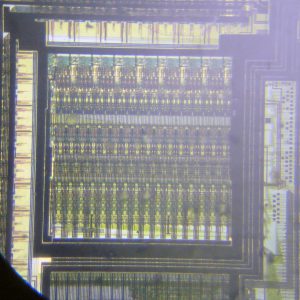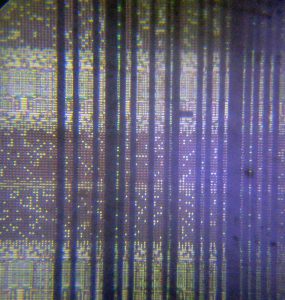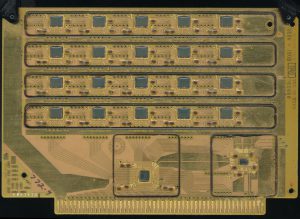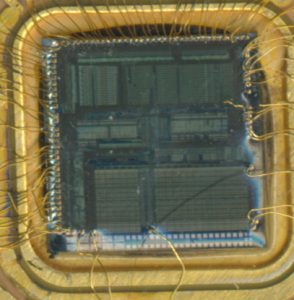CPU of the Day: FOCUS on 32-bits
The year is 1981, Intel is making the 8/16-bit 8086/8088, and Motorola has released the 16/32-bit 68000 processor to much fanfare. Motorola marketed this as the first 32-bit processor, but while it supports 32-bit instructions/data it does so with a 16-bit ALU. HP, always used the MC68000 in their 9000 Series 200 line of computers, providing rather good performance for 1981. But this was the 1980’s and HP wasn’t satisfied with good, they wanted more, they wanted to implement a full 32-bit computer on something less then the 5,000 IC’s typically used to implement one at that time. This meant making a processor like nothing else before, something with more then the 68,000 transistors of the MC68000 or even the 134,000 transistors of the new i286 Intel had announced. What HP made is simply remarkable, in 1981 they announced the HP 9000 Series 500 computers, powered by an all new fully 32-bit processor called the FOCUS. FOCUS was made on HP’s high density NMOS-III process, a 1.5u process, and used 450,000 transistors. Thats 450,000 transistors on a single 40.8mm2 piece of 1.5u silicon in 1981, a smaller die than the Intel 286.
Computers were available with the FOCUS CPU starting in November of 1982. Clock speed was 18MHz at 6V (though parts could run at 24MHz in testing). At this density electromigration becomes a concern, with the higher density, migration effects can render the chip faulty in a shorter period of time (in testing, failures occurred in weeks). For this reason HP used tungsten instead of the more traditional aluminum for the interconnects. Tungsten has a higher resistance, but much higher melting point, and much higher resistance to electromigration (over 1000 times less migration then Al). At 18MHz the resistance increase was of a smaller concern. The FOCUS generated great performance, able to achieve 1 MIPS (this is 32-bit MIPS, which was no slower on the FOCUS then 16-bit instructions, unlike its competition) , comparable to a VAX 11/780. The FOCUS also supported multi-processing, allowing up to 3 processors per system for significantly upgraded performance.
With that level of performance came significant heat, up to 5W per die. HP came up with an interesting solution. The processor die was mounting directly to the PCB. The PCB was very thick, with a thick (1mm) copper core which dissipate the heat generated by the dies. This copper core was covered in teflon, and the circuit traced (gold plated copper) applied to that. This allowed each card to dissipate, worst case, 185W. The max IC’s per card was 22, which would dissipate no more than 110W, so this gave HP a lot of margin for heat.
The FOCUS processor system consisted of 5 chips. The CPU, an I/O Processor, a Memory controller (capable of addressing up to 20 128kb chip), a 128kb RAM. and the clock driver. These were split over 3 FINstrates. One board contains the CPU, one contains the I/O controller, and one contains the memory controller + memory chips. Each board receives its own clock generator, which generates 2 non-overlapping 18MHz clocks from a 36MHz sine wave input.
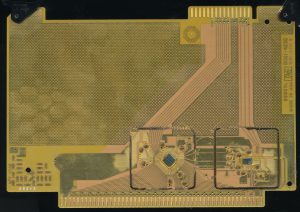
HP FOCUS CPU Board. Copper core with teflon coating. Clock chip and CPY are the only chips on the board – The dies would normally be covered by metal cans to protect them (they are also covered in a silicon coating as well)
The processor is a full 32-bit microcoded design. It is an evolution of the 16-bit Silicon on Sapphire Processor of the HP 3000 computer. Like the 3000, the FOCUS is a stack based processor (with no registers visible to the programmer, though they do exist in hardware). At its heart is a full 32-bit ALU, with 2 32-bit registers and 3 internal busses. The processor also contains 28 general purpose registers, as well as current, next, and
prefetch instruction registers. The FOCUS supports 230 38-bit instructions, operating on both 16 and 32-bit data. These are stored in a 9,216×38-bit ROM, which feeds into the PLA (Programmable Logic Array) which handle all the logic of what to actually physically do with the instructions. Floating point was supported in software, and handled by the integer ALU/bit shifter (as was typical of processors at the time). Curiously in 1982 HP offered this in their FAQ’s:
Does the system offer floating point hardware?
No. The floating point routines are coded in the microcode of the HP 9000 processor. The 9000 will perform a 32×32 [integer] multiply in 1.8 microseconds and a 64-bit FPMUL in 30.4 microseconds [worst case, typical was 10]. This offers adequate performance at present and multi-CPU configuration will, in most cases, considerably enhance it.
Adequate, is not a term HP seemed to be happy with as sometime in 1984, HP quietly added 3x FPU chips to the FOCUS CPU card (FPADD, FPMUL and FPDIV). Marketing materials simply changed from calling it the processor card to the ‘floating point processor card’. The performance increase was quite impressive, 64-bit FPMUL could now be handled in 1.28us, faster then the FOCUS could do straight integer math. This FPU chipset was likely based on the 3 chip set HP had designed for the A700 (though faster). Pricing did not change, and they became standard in all HP 9000 500 series machines. In 1985 the FP CPU was $6000 to replace, and the non-FPU was $5000, though by 1987 the situation had reversed, to NOT get the FPU hardware you needed to pay about $600 more ($5100 vs $4590).
The memory controller is capable of controlling 256K of RAM, in 20 16K chips. Each 16K chip contained 600,000 transistors, with redundant rows and columns for fault tolerance. The 20 chips provided 16 chips
(256K) for data, and the remaining 4 (64K) for error detection and correction. The Memory controller could detect and correct any 1-bit error, detect any 2-bit error, and detect most all mul-bit errors.
The FOCUS remained HP’s top of the line processor until the late 1980’s and the release of its successor, the PA-RISC. The first PA-RISC processor (the PA-7000, released in 1991) had 580,000 transistors, and was made on a 1 micron CMOS processor. This was the first processor HP made that exceeded the transistor density of the FOCUS. Intel’s first 32-bit processor, the 80386, was released in 1986, made on a 1.5 micron CMOS process it had 275,000 transistors, on a 104mm2 die. The HP FOCUS was rather ahead of its time, if not in raw performance, certainly in technology. Its not a processor that is well known or remembered, but it demonstrated technologies that even today are state of the art (such as tungsten interconnects in high heat applications).


